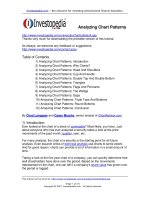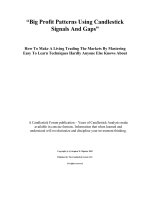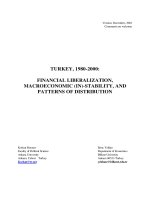Eleven elliott wave patterns
Bạn đang xem bản rút gọn của tài liệu. Xem và tải ngay bản đầy đủ của tài liệu tại đây (22.95 KB, 6 trang )
The Eleven Elliott Wave Patterns:
Motive Waves (moving with the larger trend):
Impulsive or Motive waves always move with the larger trend, consist of five waves, and are
labelled 1-2-3-4-5.
Impulse: (IM)
An Impulse is a five-wave pattern labelled 1-2-3-4-5 moving in the direction of the larger trend.
1)
2)
3)
4)
5)
6)
7)
8)
9)
10)
Wave 1 must itself be an Impulse or a Leading Diagonal pattern.
Wave 2 can be any corrective pattern except a Triangle.
No part of wave 2 can retrace more than 100% of wave 1.
Wave 3 must be an Impulse.
Wave 3 must be longer than wave 2 by price.
Wave 4 can be any corrective pattern.
Waves 2 and 4 cannot overlap.
Wave 5 must be an Impulse or an Ending Diagonal.
Wave 5 must be >= 70% of wave 4 by price.
Wave 3 must never be the shortest by price when compared to waves 1 and 5.
PDF created with FinePrint pdfFactory Pro trial version
Diagonal – also known as a Diagonal Triangle (Leading LD and Ending ED):
A Diagonal is a common 5-wave motive pattern labelled 1-2-3-4-5 that moves with the larger
trend. Diagonals move within two contracting channel lines drawn from waves 1 to 3, and from
waves 2 to 4. There exist two types of Diagonals: Leading Diagonals (LD) and Ending Diagonals
(ED). They have a different internal structure and are seen in different positions within the larger
degree pattern. Ending Diagonals are much more common than Leading Diagonals.
1)
2)
3)
4)
5)
6)
7)
8)
9)
10)
11)
12)
13)
14)
15)
16)
17)
Diagonals must move within two contracting channel lines
Channel lines must converge, slope in the same direction and not be horizontal.
Wave 1 of a LD is either an IM or a LD
Wave 1 of an ED is a Zigzag, Double or Triple Zigzag.
Wave 2 may be any corrective pattern except a Triangle.
Wave 2 is never longer than Wave 1 by price.
Wave 3 of a LD must be an IM.
Wave 3 of an ED is a Zigzag, Double or Triple Zigzag.
Wave 3 is always greater than Wave 2 by price.
Wave 4 may be any corrective pattern.
Waves 2 and 4 must overlap.
Wave 5 of an ED is a Zigzag, Double or Triple Zigzag.
Wave 5 of a LD is either an IM or ED.
Wave 3 must not be shorter by price than both Waves 1 and 5
Wave 5 must be more than 50% of Wave 4 by price.
Wave 5 is never the longest by price when compared with Wave 1 and Wave 3.
Wave 5 is never longer than Wave 3 by price.
PDF created with FinePrint pdfFactory Pro trial version
Corrective Waves (moving against the larger trend):
Corrective patterns are either 3 or 5 wave patterns, labelled with letters, and move against the
larger trend.
ZigZag:
A Zigzag is a 3-wave structure labelled A-B-C, generally moving counter to the larger trend. It is
one of the most common corrective Elliott patterns.
1)
2)
3)
4)
5)
Wave A must be an IM or a LD.
Wave B can only be a corrective pattern.
Wave B must be shorter than wave A by price distance.
Wave C must be an IM or an ED.
Wave C must be at least 70% of Wave B by price.
Double and Triple Zigzag (DZ and TZ):
Double and Triple Zigzags are similar to Zigzags, and are typically two or three Zigzag patterns
strung together with a joining wave called an x wave. They are corrective in nature.
Triples are uncommon. Zigzags, Double Zigzags and Triple Zigzags are also known as Zigzag
family patterns, or Sharp’ patterns. Double Zigzags are labelled w-x-y, while Triple Zigzags are
labelled w-x-y-xx-z. Both these patterns are included in the list of rules and guidelines below. Only
a Double Zigzag is illustrated below.
1)
2)
3)
4)
5)
6)
7)
8)
9)
Wave W must be a Zigzag.
Wave X can be any correction except an ET.
Wave X must be smaller than wave W by price.
Wave Y must be a Zigzag.
Wave Y must be greater or equal to Wave X by price.
Wave XX can be any correction except an ET.
Wave XX must be smaller than wave Y by price.
Wave Z must be a Zigzag.
Wave Z must be greater than or equal to Wave XX by price.
PDF created with FinePrint pdfFactory Pro trial version
PDF created with FinePrint pdfFactory Pro trial version
Flat:
A Flat is a three-wave pattern labelled A-B-C that generally moves sideways. It is corrective,
counter-trend and is a very common Elliott pattern.
1)
2)
3)
4)
5)
6)
Wave A can be any corrective pattern.
Wave B can be any corrective pattern except a Triangle.
Wave B must retrace at least 50% of A by price.
Wave B must be less than 200% of Wave A by price.
Wave C must be either an IM or ED.
Wave C must share some common price territory with Wave A.
Double and Triple Sideways:
Double and Triple Sideways patterns (also known as Double 3’s and Triple 3’s) are similar to
Flats, and are typically two or three corrective patterns strung together with a joining wave, called
an x wave. They are all corrective in nature. Triples are rare.
Doubles are labelled w-x-y, while Triples are labelled w-x-y-xx-z.
Both these patterns are included in the list of rules and guidelines below. Only a Double 3 is
illustrated below.
1)
2)
3)
4)
5)
7)
6)
7)
8)
9)
Wave W may be any corrective pattern except a Triangle, Double (or Triple) Zigzag or
Sideways pattern.
Wave X may be any corrective pattern except a Triangle, Double (or Triple) Zigzag or
Sideways pattern.
Wave X must retrace Wave W by at least 50%.
Wave Y may be any corrective pattern except a Double (or Triple) Zigzag or Sideways
pattern.
Wave Y cannot be a Zigzag if W is a Zigzag.
Wave Y must be less than 200% of Wave W by price.
Wave Y must be at least as long as Wave X by price except if it is a Triangle.
Wave XX may be any corrective pattern except a Triangle, Double (or Triple) Zigzag or
Sideways pattern.
The minimum XX wave retracement is 50% of Y.
Wave Z may be any corrective pattern except a Double (or Triple) Zigzag or Sideways
PDF created with FinePrint pdfFactory Pro trial version
pattern.
10)
Wave Z cannot be a Zigzag if Wave Y is a Zigzag.
11)
Wave Z must be longer than Wave XX by price.
Triangle (CT and ET):
A Triangle is a common 5-wave corrective pattern labelled A-B-C-D-E that moves counter-trend.
Triangles move within two channel lines drawn from waves A to C, and from waves B to D. A
Triangle is either Contracting (CT) or Expanding (ET) depending on whether the channel lines are
converging or expanding. Expanding Triangles are rare. Only a Contracting Triangle is illustrated
below:
1)
2)
3)
4)
5)
6)
7)
All waves in an ET must be ZZ, DZ, or TZ.
In a CT:
Wave A is restricted to a ZZ, DZ, TZ or FL.
Wave B is restricted to a ZZ, DZ, or TZ.
Wave C is any corrective pattern except a Triangle
Wave D is any corrective pattern except a Triangle
Wave E is restricted to a CT, ZZ, DZ, or TZ.
The intersection of the channel lines must occur beyond the end of a CT, and before the
beginning of an ET
The channel lines must either converge or diverge. They cannot be parallel.
Only one channel line in a CT may be horizontal.
Neither channel line of an ET can be horizontal.
Wave E must end in the price territory of A.
PDF created with FinePrint pdfFactory Pro trial version









